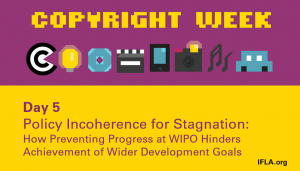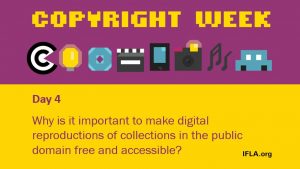Last month’s 42nd meeting of the World Intellectual Property Organisation’s (WIPO) Standing Committee on Copyright and Related rights (SCCR) was, at the same time, a breath of fresh air, and a return to the norm.
It was certainly welcome to be able to engage, once again, with delegates in person. Fora like WIPO offer great opportunities to interact with government representatives in order to understand more clearly their priorities and concerns, and to share the experiences of libraries.
There was also, thanks to the initiative of the African Group, the first Member State-led effort in many years to define and drive forwards the agenda on exceptions and limitations to copyright for libraries, archives, museums, education and research.
While only a part of the proposals made it through this time around, it is very positive news that libraries and their users can count on some governments at least to defend their interests.
This same point is, at the same time, also a reason for some disappointment. Despite the extreme caution in the proposals to adhere to consensus positions previously stated in the Committee, some groups – notably richer countries, continued to look to emaciate any effort to move SCCR in the direction of work that would bring benefits to libraries and their users.
While the rest of the African group proposal remains on the table for the next meeting, it was only a proposed information session on cross-border working, as well as a toolkit on preservation that had already been in the works, and a scoping study on a research toolkit that made it through this time around.
In their resistance to progress, developed countries could cite the support of rightholder organisations that looked both to warn against any extension of limitations and exceptions (L&Es), and which suggested that the status quo – at least as concerns L&Es – is adequate.
So why was this the case? This blog looks to explore some of the underlying themes which can help explain this situation.
We are not always talking about the same thing when we are talking about copyright: during exchanges between Member States, observers and experts, it became clear that two definitions of copyright were in use.
The narrower one sees copyright as being only about the exclusive rights given to rightholders, for example to reproduce, translate, or use works. The wider one – used for example by Professor Raquel Xalabarder – looks at copyright as a wider system, incorporating both rights and exceptions and limitations to them.
The argument for a latter approach is based on the core goals set out in texts such as the Berne Convention and beyond – i.e. that copyright should serve to support the production and dissemination of new ideas. Given how important access to and use of existing works is to the production of new ones, it makes sense that copyright needs to be seen as including the L&Es that allow this.
This wider approach is welcome, representing a more enlightened and constructive approach that of course takes account of the contribution of libraries. It also helps us get beyond the tired and blinkered cliché that any non-remunerated use of works is tantamount to stealing.
There remains, in some quarters, a refusal to accept that the public interest should be considered: a revealing statement was made by one observer from a rightholder lobby during discussions, when he argued that the public interest should never come at the expense of that of rightholders. This explicit argument for an unbalanced copyright system is something that you rarely hear spoken out loud.
This highlights the need for spaces like WIPO where governments can indeed take into account arguments from different perspectives on the way in which copyright systems should be designed, if they are to achieve their goal of delivering the best outcomes for societies as a whole.
This is not of course to say that protection of the interests of rightholders is not in the wider public interest. It is, up to a point. However, when the marginal benefits of protecting these private interests are outweighed by the costs to society of denying access and usage possibilities, governments need to act.
There is an assumption that while access concerns should be balanced by rightholder concerns, rightholder concerns should not be balanced by access concerns: closely linked to the previous point, the structure of the research report presented during the information session on the first day of SCCR is telling.
The first half of the report focused on the experience of rightholders during the pandemic, and how in particular the shift to digital had impacted the revenues of different categories of creator and intermediary. This underlined the hardship that many in the book sector had studied, but then presented, uncritically, the steps taken by some publishers at least to facilitate access.
The second half talked about libraries, archives, museums, educators and researchers. Beyond a tendency to indicate that the real problems lay outside of copyright, for example in funding (a point which is partially true, but does not take away from the need for copyright reform), the report felt the need to suggest that enabling libraries to do their jobs better in a digital world nonetheless should not come at the expense of rightholder interests.
This is revealing, sadly underlining a presumption – a prejudice even – that somehow the interests of libraries and their users need to be balanced, but those of rightholders do not.
There is a challenge around the supply of digital content, but is freezing work on L&Es the answer?: a fundamental question raised by both ‘sides’ of the debate – and which the WIPO Secretariat to their credit has certainly recognised – is that an key underpinning issue is the fact that there simply isn’t enough affordable, accessible, digital content out there.
Given the size of the internet, this may seem like an odd claim, but for many in schools and research centres, it is the case, with materials either stuck behind unscalable paywalls, not available in relevant languages, or simply not existing on topics and contexts that matter.
Advocates for rightholder organisations suggest that a key factor in this undersupply is a fear that if works are made available in digital format, they will be pirated, and demand for them will evaporate. As a secondary argument, they also claim that digital-adapted L&Es will also suppress the market.
Of course, the first question is one of enforcement, not basic copyright laws, while the second goes back to the arguments above about the degree to which the work of libraries strengthens or weakens markets for books and other materials.
The counter-argument here of course is that libraries offer an excellent means of providing access to digital content in a way that can be better controlled, using effective tools, and of course that the work of libraries represents a guarantee of research, innovation and creativity in the future, not a threat to it.
Indeed, we can argue that this is rather a failure of the market to respond to demand, driven perhaps by a lack of capacity, but also perhaps by fear and uncertainty among actors who more or less control the market.
This is not the first time that WIPO has addressed the issue of the under-supply of content in formats that work for readers. It’s exactly the challenge that the Marrakesh Treaty looked to overcome.
While international legal action around L&Es remains only one of the options on the table for now to resolve this failure (although arguably, there’s no other way of dealing definitively with challenges around cross-border working), it would undoubtedly have a strong triggering effect on national legislation.
This blog has looked to provide insight into some of the assumptions and understandings that explain position taken, and outcomes achieved, at SCCR. Addressing them, and finding solutions, will need to be part of any ongoing strategy to achieve progress.
As a final point, of course, it is worth noting that copyright can of course tend to polarise, whereas on most issues, the interests of rightholders, libraries and their users converge. Setting aside pure profit motives, we all, deep down, work towards a situation where there is a rich production of relevant materials, and literate, curious populations that are eager to read and apply knowledge. Despite the various points of disagreement in fora like WIPO, it is good to remember that we are all there for the same ultimate purpose.

